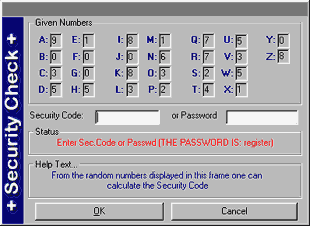TimeWatcher offers some functions
to protect the computer, while it is running in timing mode. These provide protection
against misuse of the computer and cheating on TimeWatcher.
The supervisor can define programs, which
TimeWatcher will block. This is for example useful, to avoid, that a user plays around
with the settings of a computer. Parents can use this function to block programs, which
they don't want their children to use, for example a Web Browser.
To make sure that a user can't read the
TimeWatcher password from the typing fingers of the supervisor, we invented a new security
method

Instead of using the same password every time
the supervisor can use a security formula. With this formula, the supervisor calculates a
security code, which changes every time. That sounds very complicated, but in fact it is
easy. Here an example. Let's say the security formula is "AEI" and the above
security dialog comes up. The right code would be the number at A (=9), the number at E
(=1) and the number at I (=8), which makes 918.
After a while, this system is even easier to use
then passwords and a lot more secure.
TimeWatcher makes use of many different security
concepts. To provide protection against exiting the program, TimeWatcher disables the
windows hotkeys, so the computer can not be rebooted with CTRL-ALT-DEL and the TimeWatcher
program task can't be suspended.... |






